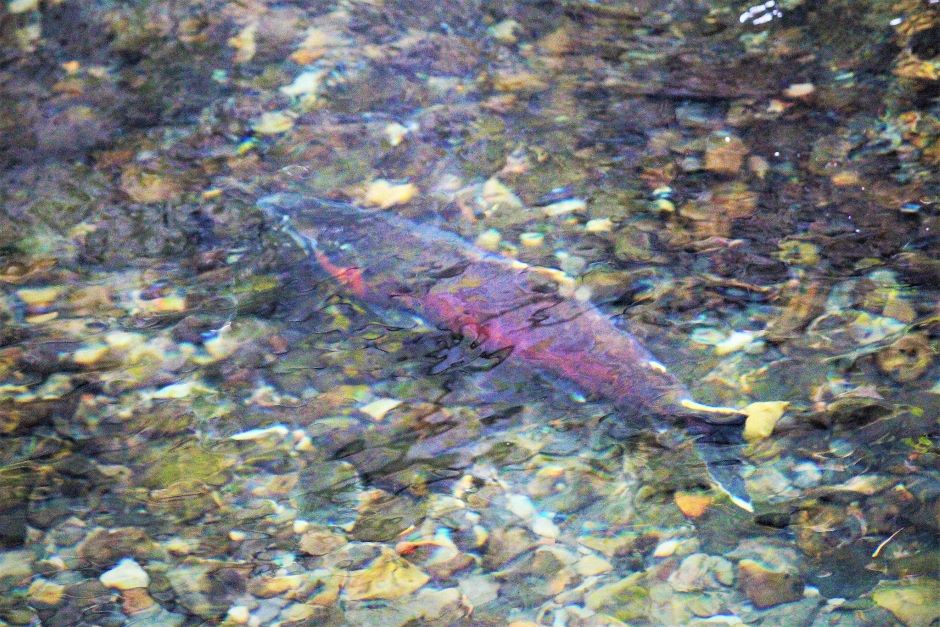Protecting Salmon Habitats for the Future
 A Coho salmon in its spawning season in lower Multnomah Creek below the waterfall (Credit: Richardmouser, CC BY-NC 4.0)
A Coho salmon in its spawning season in lower Multnomah Creek below the waterfall (Credit: Richardmouser, CC BY-NC 4.0)Considering the popularity of salmon in the U.S., it’s no surprise that conservation groups and fishery managers are always on the prowl for methods and means to improve the quality of life for salmon. One factor that impacts salmon’s spawning viability and their migration pattern is the quality of salmon habitats.
Further, National Geographic reports that the U.S. alone consumes a whopping 450,000 tons of salmon every year—making salmon an important part of the global economy. National Geographic continues, “Today, all Atlantic salmon consumed in the U.S. is farmed, often imported from as far away as Chile, Scotland, and Norway.”
Atlantic Salmon Habitats
According to NOAA Fisheries, “There are three groups of Atlantic salmon: North American, European, and Baltic.” As the names imply, these salmon are found in North America, Iceland, Greenland, Europe, and Russia. After spawning, Atlantic salmon migrate through various parts of the North Atlantic and often find themselves off the coast of Greenland, sharing feeding grounds with variants from other parts of the world.
The Nature Conservancy highlights the importance of debris for salmon habitats. Salmon rely on dead trees and debris as safe havens for eggs and a place to rest. Debris also helps to maintain water depths and keep streams hospitable.
Salmon are particularly unique from other fish due to their ability to adapt and survive in both fresh and saltwater environments. Not only do the fish survive, but the anadromous species thrives in both ecosystems. The World Wildlife Foundation explains this uniqueness in comparison to other species saying, “When saltwater fish are exposed to freshwater, it can cause their cells to burst. And when freshwater fish are exposed to salt water, it can cause their cells to shrivel, due to a process known as osmoregulation.”
Another factor that is often not considered since salmon spend part of their life in the ocean, far away from the shady shorelines of rivers and streams, is the incorporation of terrestrial and aquatic vegetation in salmon habitats. Keeping streams shady helps protect water from warming too easily or quickly, something that can be detrimental to salmon health.
Aquatic vegetation functions similarly to woody debris in providing a place for salmon to lay eggs and hatch. The benefit of aquatic vegetation is that there is usually a lot of it, and it can reduce competition between fish, allowing for more significant spawning seasons.
Why are Salmon Important to Ecosystems?
First and foremost, salmon are a significant part of the diets of both animals and humans alike. Brown bears see salmon as key prey, and indigenous communities rely on salmon for food security throughout the winter. Because salmon are such a major part of the ecological chain, scientists have deemed the species to be a keystone species. Keystone species are generally described as species that have a disproportionately large impact on their ecosystems. As a result, if a keystone species were to disappear, ecosystems would change significantly.
The WWF reports, “Scientists have traced nutrients from salmon bodies and found them in mosses, herbs, shrubs, trees, insects, song birds, bears and wolves!” Salmon also function as bio-indicators of stream health. As streams in Alaska warm, fewer salmon have made their return, indicating that the stream is no longer hospitable to the same life that it used to support.
Salmon runs involve the fish swimming upstream from the ocean, bringing with them a plethora of marine nutrients from the ocean. Low-productivity rivers benefit from these nutrients, which are dispersed to and by multiple organisms within the ecosystem. Environments that meet the needs of salmon habitats are bettered by the presence of salmon in the area.
The Wild Salmon Center provides the following example “Sockeye salmon runs in southwest Alaska contribute up to 170 tons of phosphorous per year to Lake Illiamna.” The nutrients provided by the salmon run in Lake Illiamna will become a part of the food web and then utilized by over 50 species of mammals, birds, and fish that forage on salmon eggs, juveniles, and adults in freshwater.
Brown bears that eat salmon will also transplant these nutrients onto the land, which is then used by forests and other terrestrial organisms. Salmon also serve as a cultural element for many native groups in the U.S., and one example is the Tlingit people of Southeast Alaska.
The Tribe has always believed the salmon to be a gift and spiritually relevant in the Tribe’s history. The Wild Salmon Center explains, “The Tlingit pay their respects by returning the bones of salmon to the sea; the bones eventually reincarnate as living salmon that return as the next run.” Protecting wild salmon means preserving historical practices and future ecosystem stability.
Conclusion
As seafood becomes more of a necessity for future food security, there is no doubt that salmon will play an important role. However, it is important to note that in considering the future, the public must take precautions in the present. Salmon and their ecological function are tangible and deeply rooted in tradition, nature, and regional stability—protecting and preserving salmon habitats are a matter of public interest.


0 comments